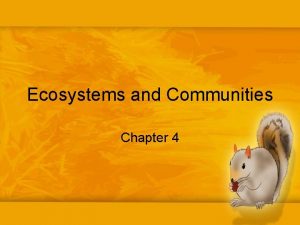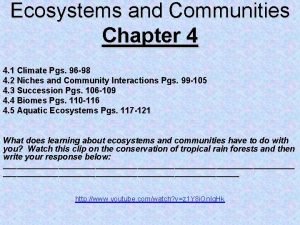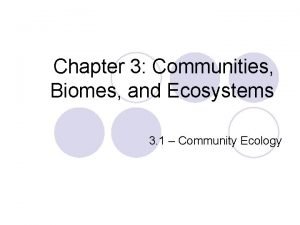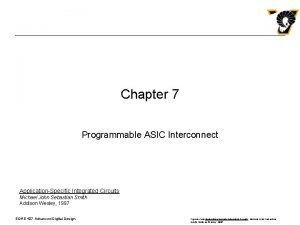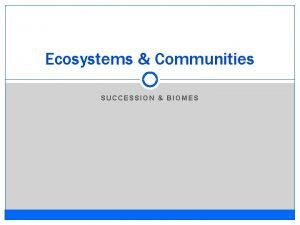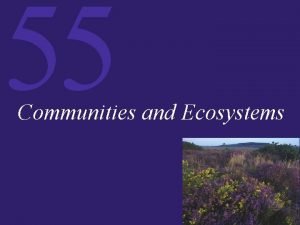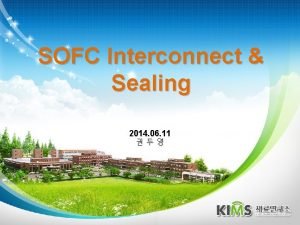Communities physical processes interconnect to form ecosystems Ecosystems













- Slides: 13

Communities + physical processes interconnect to form ecosystems Ecosystems are connected by: 1. energy flow between trophic levels; energy also released as heat energy into environment • Autotrophs = 10 producers – Primary productivity = amount of C fixed in an ecosystem by: CO 2 + H 20 + light --> (C 6 H 1206) + O 2 • Heterotrophs – Consumers: herbivores, omnivores, carnivores – Decomposers 2. Nutrient and water cycling (Biogeochemical cycling) 1. water, 2. carbon, 3. nitrogen, 4. phosphorus Humans have impacts on ecosystems

Energy flow (also refer to Fig. 20. 3 & 20. 7) • Only ~10 % transfers between levels. • Loss due to: Metabolism and waste

Bio. Geo. Chemical cycles = Nutrients cycle btwn biotic & abiotic forms Definitions of: Reservoirs and fluxes, mineralization, fixation/assimilation Flux rate dependent on ? Major Biogeochemical cycles: Atmospheric cycles = carbon and nitrogen; Sedimentary = phosphorus; Hydrologic 9 9

Carbon • Reservoirs = ? • Transformations?

Nitrogen - why is N impt? - what is symbiotic N fixation? - cause and results of excess N? N 2 Nitrogen fixation Dead organisms Rhizobium Decomposition Fungi, bacteria, inverts Plants Organic matter Mineralization Assimilation Denitrification Anaerobic bacteria Fungi, bacteria NH 4+ NO 2 - NO 3 - ammonium nitrite nitrate Industrial inputs: Fertilizer, atmospheric deposition

Phosphorus Pools? Transformations? Cause and consequences of excess P in aquatic systems

–PO 4 - is difficult to acquire – 80 % of plants have mycorrhizal symbionts to help (fungi); other benefits (+H 20) offset cost

• Biotic factors increase nutrient retention – how? • Excessive disturbance decreases retention – why?

Human Impact 1 • Reduced biodiversity, habitat loss, habitat fragmentation

Human Impact 2 • Pollution: air, water, land • Reduction in ozone layer

Human Impact 3 - Excess N & P

Human Impact 4 - Accelerated release of CO 2

 Sere in ecology
Sere in ecology Chapter 4 ecosystems and communities
Chapter 4 ecosystems and communities Chapter 4 ecosystems and communities
Chapter 4 ecosystems and communities Communities biomes and ecosystems
Communities biomes and ecosystems Concurrent in os
Concurrent in os Sip interconnect
Sip interconnect Virtual protocol interconnect
Virtual protocol interconnect Optical interconnect
Optical interconnect Optical interconnect solutions
Optical interconnect solutions Characteristics of network topology
Characteristics of network topology Programmable asic
Programmable asic Rating engine in telecom
Rating engine in telecom Cross building interconnect
Cross building interconnect Quick path interconnect
Quick path interconnect

